Service level (SLA) is one of the most critical metrics in a contact centre, directly impacting customer experience and operational efficiency. But how exactly is it calculated, and what factors influence it?
In this article, we will provide you with the best formula, methods and advice on how to calculate service level in the call centre.
The Service Level Formula
The service level formula is simply the number of calls answered within the service level threshold divided by the number of calls offered, multiplied by 100.
Service Level = (Number of Calls Answered Within the Service Level Threshold ÷ Number of Calls Offered) x 100

This then gives you a percentage service level. It’s really as easy as this.
For example, if a company has an objective to answer 80% of all calls within 20 seconds, the Service Level Threshold is 20 seconds.
Worked Example
Both of the pieces of information used in the calculation below can be taken from the contact centre’s Automated Call Distribution (ACD) system or, failing this, can be gathered from Call Detail Records (CDRs).
Number of calls answered within the service level threshold = 136
Number of calls offered = 170

A new service level should be calculated for each new reporting period, which for most contact centres would be every half hour, if it is impossible to do so in real time.
By doing this, the contact centre can see whether or not they have the correct number of advisors to handle varying call volumes throughout the day.
To calculate staff numbers to meet a target service level, read our article: How to Work Out How Many Staff You Need in a Contact Centre
Things to Consider For Service Level Calculations
Should Calls That Abandon Within Five Seconds Be Discounted?
Some algorithms ignore short abandoned durations of less than 5 seconds in their service level calculations.

This is because people may have dialled the wrong number in error and then hung up. This can be configured on many ACD systems. This is generally seen as being OK.
“It’s less than one ring cycle and some ACDs may not have even delivered it to a turret even though the customer is hearing a ring,” said Dave Appleby, an experienced resource planner.
So, excluding short abandoned calls, the revised formula becomes:

Should ALL Abandoned Calls Be Excluded?
The short answer to this is no.
An abandoned call is a call that has been offered and you had the chance to answer it. The rate at which calls abandon, though, does, unsurprisingly, vary according to call type. This is highlighted in the graph below.
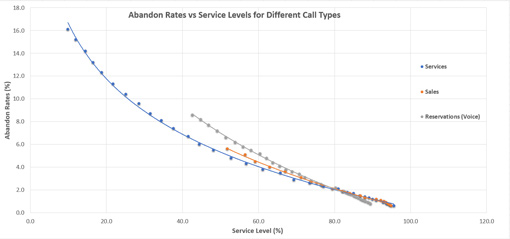
As all of the lines seem to meet at 80%, it is no wonder this has become the industry standard.
If you want to know how you can predict call abandon rates, read our article: How to Predict Call Abandon Rates Based on Service Level
Timing Generally Starts After the IVR Selection
Generally, the service level time starts post-IVR selection.
Service Level is based on ‘Of the calls you COULD have answered, how many were answered in x seconds?’
Dave Appleby
“I’ve not come across anyone who does it the other way. The rationale being that service level is based on ‘Of the calls you COULD have answered, how many were answered in x seconds?’,” said Dave Appleby.
However, keeping a separate track of the number of calls that “drop-out” of the IVR can be be a useful measure of its effectiveness.
Be Careful With ACD Stats
On certain ACD systems the service level displayed on the wallboards could be misleading.
For example – you have a service level target of 80% of calls answered in 20 seconds. A 100% service level figure on your ACD stats does not mean that 100% of calls were answered within 20 seconds.
The 100% figure actually means that 100% of calls met the service level target (i.e. 100% of 80% of calls were answered within the target). Similarly, a service level figure of 80% may only mean that 64% of calls (80% of 80%) were answered in the threshold time. This has certainly confused many people.
In this case, it would be safer just to display the percentage of calls answered within 20 seconds.
For more advice on this topic, read our article: What Information Should You Be Displaying on Your Contact Centre Wallboards?
Industry Standards for Service Levels
- Phone: 80% of calls answered within 20 seconds
- Email: 100% of emails answered within 24 hours
- Live Chat: 80% of chats answered within 20 seconds
- Letters – 95% of letters answered within three days
- SMS/messaging apps – 80% of messages responded to within 20 seconds
Do You Have to Stick to the Industry Standards for Service Level?
As noted earlier, most contact centres stick to the industry standards of service level, which is to answer 80% of calls in 20 seconds.
However, there are signs to suggest that contact centres are starting to relax their service levels. According to our white paper, “What Contact Centres Are Doing Right Now“, the number of contact centre professionals who would consider service level as a “very important” metric has decreased from 70.0% to 62.7% in just twelve months.
Those who are thinking in this way could be questioning the impact of service level on Customer Satisfaction (CSat) and argue that spending more time on ensuring First Call Resolution (FCR) would please customers more than focusing on meeting a particular service level.
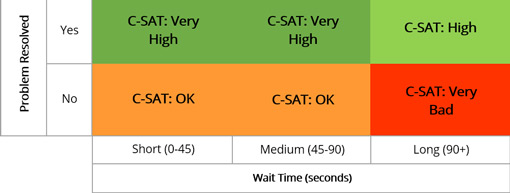
The table above was taken from our article: “Is There a Correlation Between Queue Time and Customer Satisfaction Levels?” And it demonstrates that queue times don’t have a major impact on customer satisfaction, as long as the call is resolved.
However, while this is a good case for not targeting advisors against time-based metrics, calculating service level is still an important part of workforce management (WFM) for many contact centres.
For more industry standards of common contact centre metrics, like service level, read our article: What Are the Industry Standards for Call Centre Metrics?
How People Manipulate Service Levels
As with all metrics, as soon as people see that a metric is important, then they will start to manipulate the results.
Here are the three most common ways that service level results are manipulated:
1. Excluding Abandoned Calls
The easiest way that people can fiddle the service level figures is to exclude abandoned calls from the calculation.
For example, the Cisco contact centre software allows for three different ways of calculating service level.
Abandoned Calls Have a Negative Impact on Service Level (This is the correct method)
The number of calls answered within the threshold divided by the number of calls that had a service level event. This treats these abandoned calls as though they had exceeded the threshold.
Abandoned Calls Have No Impact on Service Level (Should not be used)
The number of calls answered within the threshold divided by the number of calls that had a service level event minus the number of calls that were abandoned before exceeding the service level threshold. Calls abandoned before the service level threshold expired are removed from this calculation.
Abandoned Calls Have a Positive Impact on Service Level (Is used to manipulate service levels)
The number of calls answered within the threshold plus the number of calls abandoned within the threshold, all divided by the number of calls that had a service level event. This treats these abandoned calls as though they were answered within the threshold.
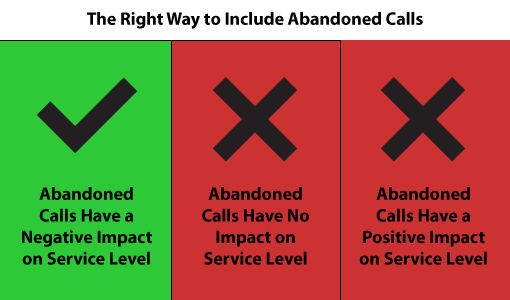
2. Changing the Targets (albeit temporarily)
I know of an on-the-spot decision by a director, who changed the service level from 90/15 to 80/20 and then recalculated the quarter just so they didn’t miss the target!
3. Putting in a Call-Screening Group
Some companies put in place a call-screening or triage group. This is similar to the company switchboard in that this quickly answers the calls before transferring them to a longer queue in the appropriate department.
This is sometimes used to cover up service level problems. For example, a few years ago, one of the regulators put in place a metric on the speed of answer of telephone calls.
For more insights into contact centre service levels, read our articles:
- What Are the Contact Centre Service Level Standards?
- 14 Best Practices for Maximizing Your Service Level
- What Is Causing Your Service Levels to Fail?
Author: Jonty Pearce
Reviewed by: Hannah Swankie
Published On: 22nd Nov 2017 - Last modified: 5th Feb 2025
Read more about - Call Centre Management, Abandoned Calls, Automatic Call Distributor (ACD), Dave Appleby, Featured Articles, How to Calculate, Service Level







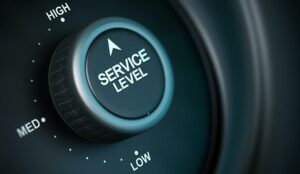
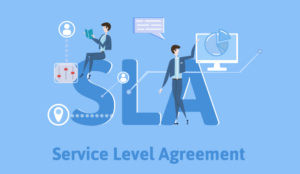
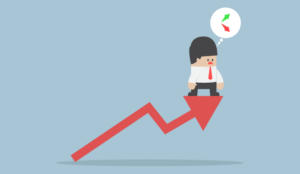






Old thread but for people who are saying that abandoned should be ignored because some calls are getting abandoned before the threshold. Calls getting abandoned before the threshold are called as short abandoned and they don’t impact your SL in any ways. If calculated properly, It helps boost your SL.
Service Level = {(Total calls answered within threshold +calls abandoned within a shorter amount of time than the threshold)/(total calls answered + total calls abandoned)} * 100%
Service level for emails, post, social media and web chat
For emails, post, social media and web chat the same basic formula holds
Service level = [ Number of contacts answered within the service level threshold] / [Number of contacts offered] * 100
Including abandoned calls in the Service Level calculation is the right thing to do if you respect your customers. The short call threshold takes into consideration calls that you determine really weren’t valid calls and didn’t give the call center a reasonable chance to answer. I think a reasonable short threshold is 5 to 10 seconds. After that why should anyone be surprised that a customer might reasonably expect to have their call answered with a minimum wait time? Customers don’t know or care what your internal goal is. Excluding abandons that drop before the Service Time is theoretically the same as setting your short call threshold to the same thing as your goal time.
Most of the opinions expressed that would like to see abandons excluded from the calculation are probably looking at it from the call center point of view and are concerned with what they are being held accountable to. This is not a customer centric approach.
The Service Level approach described and recommended in the article is taking into consideration the customer experience. By including abandons in the calculation you are better able to see what your customers are experiencing and potentially hearing what they expect.
Simple example – Business sets a goal of 80% in 60 seconds. If they are offered 100 calls and 99 of them abandon between 30 and 45 seconds in queue and the one remaining call is answered at 65 second what is the resulting Service Level? If you include the abandons you’re looking at a 1% Service Level. If you exclude them, congratulations, you’re at 99%! Now don’t we feel good about ourselves, we exceeded our SL goal! Yes, I’m sure we’ll get around to looking at the abandonment rate separately and we might figure out what our customers are trying to tell us… That they aren’t willing to wait 60 seconds to have their call answered and they’re taking their business elsewhere.
Even if you’re the only game in town isn’t the whole point of providing a service is to provide a good service that meets your customer’s needs? There are a lot of valid reasons why a center can’t support a more aggressive, customer friendly service level goal. But even if the center can’t do 80% in 30 seconds shouldn’t we really know how what percent of our callers are getting that experience rather than fooling ourselves into believing that we are meeting their needs?